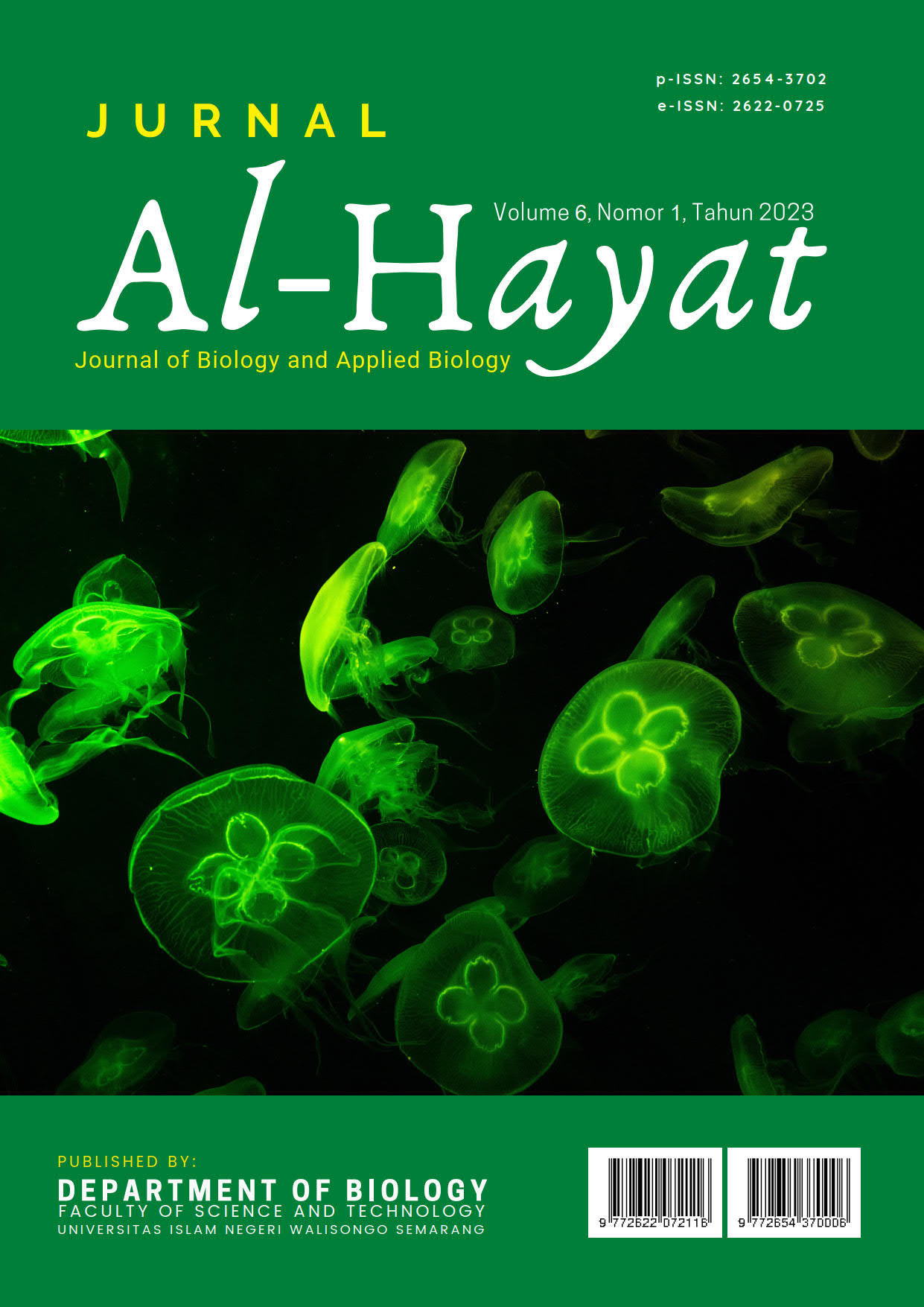Description of polimorfism FTO Gene (Fat and Mass Obesity associated) rs9939609 on Obesity and Non Obesity Subject
Main Article Content
Abstract
Obesity is a major risk factor for several chronic diseases and is a major health and economic burden on society. The FTO gene (Fat and Mass Obesity associated) was identified as a gene that has an influence on the incidence of obesity according to Genome-wide Association Studies. Examination of the FTO gene polymorphism rs9939609 using 15 samples of obese subjects and 15 samples of non-obese subjects at Prodia Pusat Jakarta employees. This study used descriptive research to describe the polymorphism or variation of the FTO (Fat mass and obesity-associated) gene rs9939609 in obese and non-obese objects among Prodia Pusat Jakarta employees. In this study, non-obese subjects obtained 100% AT allele results. This indicates that genetically there is a potential risk factor for obesity. In obese subjects, 60% of the TT alleles were found. Genetically it should not be a risk allele for the risk of obesity. This can be caused by lifestyle or diet. In this study, an AA allele of 6.67% was found, indicating a greater risk of obesity. From the study, it was concluded that the percentage of the FTO gene polymorphism rs9939609 in obese and non-obese subjects in Prodia Pusat Jakarta employees was the AT allele 100% for obese subjects and for obese subjects. non-obese subject of 33.33%. The AA allele is 6.67% for obese subjects, and the TT allele is 60% for obese subjects.
Downloads
Article Details
The copyright of the received article shall be assigned to the journal as the publisher of the journal. The intended copyright includes the right to publish the article in various forms (including reprints). The journal maintains the publishing rights to the published articles. Authors are allowed to use their articles for any legal purposes deemed necessary without written permission from the journal with an acknowledgment of initial publication to this journal.
The work under license Creative Commons Attribution-ShareAlike 4.0 International License.
References
(WHO), W. H. (2016). 10 Facts on obesity. . https://www.who.int/features/factfi les/obesity/facts/en/.
(WHO)., W. H. (2016). Obesity. https://www.who.int/topics/obesity/en/.
A. van der Klaauw and I. S. Farooqi. (2015). “The hunger genes: pathways to obesity,” . Cell, vol. 161, no. 1, , pp. 119–132, .
Chan, Y. Y. (2017). Aktivitas Fisik dan Kegemukan/Obesitas di antara Orang Dewasa Malaysia: Temuan dari Survei Kesehatan dan Morbiditas Nasional (NHMS). BMC Kesehatan Masyarakat 733917), :1-31.
Chey, W. W. (2013.). Association of fat Mass and Obesity- Associated (FTO) gene rs9939609 variant with obesity among multi-ethnic Malaysians in Kampar, Perak. . Sains Malaysiana, , 42(3), 365- 371.
Flegal KM, C. M. (2012). Prevalence of obesity and trends in the distribution of body mass index among US adults, 1999-2010. . JAMA, 307: 491–497.
Frayling, T. T. (2007). A common variant in the FTO gene is associated with body mass index and predisposes to childhood and adult obesity. . Science , 316(5826) :889-894.
Geneaid. (2017). Genomic DNA Mini Kit (Blood/Culture Cell) Fresh Blood Protocol Insert. www.geneaid.com Ver.02.10.17.
J. M. McCarery, G. D. (2012). “Obesity susceptibility loci and dietary intake in the Look AHEAD Trial,”. American Journal of Clinical Nutrition,, vol. 95, no. 6, pp. 1477–1486.
J. Wardle, S. C. (2008). Obesity associated genetic variation in FTO is associated with diminished satiety. Journal of Clinical Endocrinology and Metabolism, , vol. 93, no. 9, pp. 3640–3643.
K. Hotta, Y. N. (2008.). “Variations in the FTO gene are associated with severe obesity in the Japanese,” . Journal of Human Genetics, , vol. 53, no. 6, pp. 546– 553,.
Kartika, A. I. (2018). Optimasi Annealing Temperature Primer mRNA RECK dengan Metode One Step qRT-PCR. . Jurnal Labora Medika, , 2(1), 22–31.
M. Ng, T. F. (2013). “Global, regional, and national prevalence of overweight and obesity in children and adults during 1980– 2013: a systematic analysis for the Global Burden of Disease Study 2013,. The Lancet, vol. 384, no. 9945, , pp. 766–781.
Maharani C, P. A. (2019). Peran Variasi Gen FTO pada Obesitas. Jambi Med J., 7(2):161–6.
Merra G, G. P. (2020). FTO rs9939609 influence on adipose tissue localization in the Italian population. . Eur Rev Med Pharmacol Sci. , 24(6):3223–35.
Nurhasanah, N. P. (2022). Analisis Asupan Karbohidrat Dan Lemak Pada Dewasa Muda Dengan obesitas sentral di Fakultas Kedokteran universitas riau. Jurnal Ilmu Kedokteran (Journal of Medical Science), , 16(1),16.
Q. Qi, T. O. ( 2014.). FTO genetic variants, dietary intake and body mass index: insights from 177,330 individuals. Human Molecular Genetics, , vol. 23, no. 25, pp. 6961–6972.
Rahardianti, R. &. (2017). Akurasi Metode Real PCR Untuk Analisa Ekspresi Gen PmVRP15. . Prosiding Pertemuan Teknis Teknisi Litkayasa Lingkup BBPBAP Jepara, , 1-166.
Septiyanti, S. (2020). Obesitas dan Obesitas Sentral pada Masyarakat Usia Dewasa di Daerah Perkotaan Indonesia, . Jurnal Ilmiah Kesehatan , Vol.2 No.3 .
Seto P, A. H. (2013). Polymorphism of fat Mass Obesity Assosiaceted (FTO) gene as a risk Factor for Type 2 Diabetes melitus with Metabolic Syndrome. . Jurnal Kedokteran Vol.11.
Sudargo T, F. H. (2014). Pola makan dan obesitas. Yogyakarta: Gadjah Mada University Press.
T. Berentzen, S. I. ( 2008). Lack of association of fatness-related FTO gene variants with energy expenditure or physical activity. Journal of Clinical Endocrinology and Metabolism, , vol. 93, no. 7, pp. 2904–2908,.
Ursu RI, B. C. (2015; ). Studi tentang polimorfisme gen rs9939609 dalam hubungannya dengan obesitas dan pengelolaan obesitas pada kohort Rumania, . J Med Life, , 8: 232-8.
Widayat, W. A.-B. (2019). Real Time- Polymerase Chain Reaction (RT- PCR) sebagai Alat Deteksi DNA Babi dalam Beberapa Produk Non- Pangan. . Indonesia Journal of Halal, , 2(1), 26-33.
Y. Sun, J. S. (2010). “Variants in the fat mass and obesity associated (FTO) gene are associated with obesity and C- reactive protein levels in Chinese Han populations,”. Clinical and Investigative Medicine,, vol. 33, no. 6, pp. E405.

